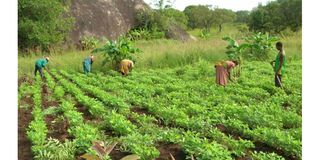Why agriculture should be a priority in new SMEs policy

What you need to know:
- Stakeholders anticipate that the new SMEs policy will encourage thorough reforms of the industry to promote the expansion of businesses
Dar es Salaam. The government is reviewing the Small and Medium Enterprises Development policy of 2003 to facilitate the growth of the key sector in the midst of shifting circumstances.
The review of this important piece of legislation will go in tandem with updating related documents namely the National Investment Policy of 1996, National Business Policy of 2003 and the Agricultural Marketing Policy of 2008.
The review process is in advanced stages, according to the minister for Investments, Industries and Trade, Dr Ashatu Kijaju. “The policies are being reviewed to make them relevant and implementable in the changing business, economic and technological environment,” Dr Kijaju. The policy review is also being undertaken to streamline it with development visions and strategies.
Stakeholders hope that in the new SMEs policy the government will facilitate comprehensive reforms of the sector to facilitate the growth of enterprises across the board.
Of particular importance is the inclusion of the agricultural sector in the SMEs policy as the 2003 policy excluded non-farm activities. The policy focused on micro, small and medium enterprises in manufacturing, mining, commerce and in the services sector. While agro-processing fell into one of these categories, the exclusion of farming which is the key source of raw materials for industries-farming- meant that agriculture and industries were pulled into different directions. In other words, farming and agro-processing were not reading off the same script as far as the agricultural value chain was concerned. But now that the government is aggressively seeking to commercialise smallholding it is time to seize the opportunity to include farm activities in the new SMEs policy.
In commercialising smallholding the government has undertaken various things. It has ensured that farm inputs, especially fertilisers, are readily and cheaply available across the country. Also the government has permanently opened up cross-border markets for food crops such as maize grains, rice and beans to enable a return for the money of smallholders. But most of the crops are sold to neighbouring countries without being processed.
As it was launched in 2003 the existing policy observed that “... in Tanzania, the full potential of the SME sector has yet to be tapped due to the existence of a number of constraints hampering the development of the sector.”
The policy went on to mention the constraints as including unfavourable legal and regulatory framework, undeveloped infrastructure, poor business development services, limited access of SMEs to finance, ineffective and poorly coordinated institutional support framework.
The policy was seeking to address most of these constraints. Twenty years later it is obvious that the policy has fallen short, which necessitates review. Some SMEs that existed then are still micro or small or medium. Some have closed down. Some that were medium sized might have been downgraded to small or micro.
When smallholders are included in the SMEs category they will begin regarding themselves not as poor farmers tilling the land for subsistence but as entrepreneurs. This, in fact, is the vision of President Samia Suluhu Hassan; to turn farmers into businesses. When farmers become entrepreneurs and are linked directly into agro processing as part of their ventures it will help cut out middle men who have for long enriched themselves from the backs of poor farmers. Agriculture is also the most dominant economic sector in Tanzania. It is true that the economic growth is now moving towards manufacturing and the services sector with the gross domestic product of many sectors eating into that of agriculture as a result the agriculture has declined from more than 80 per cent of GDP at independence in 1961 to 26.9 per cent of the GDP in 2020. It is also the largest employer with more than half of all jobs (58.1 per cent in 2019) coming from agriculture.
It is also the largest source of raw materials and the best tool that the government can deploy to end unemployment among the youth and income poverty in households in the country.



